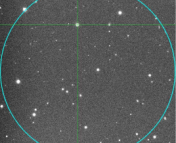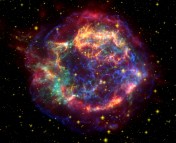Title: The Crucial Role of Higher-Order Multiplicity in Wide Binary Formation: A Case Study Using the β-Pictoris Moving Group
Authors: P. Elliott and A. Bayo
First Author’s Institution: European Southern Observatory, Santiago, Chile
Status: Accepted to MNRAS
When it comes to counting stars, one plus one equals three—if not more. Although most stars in the sky appear deceivingly solitary, the lenses of ever more powerful telescopes or a tell-tale, periodic red to blue wobbling of a star’s spectrum reveal companions. Our familiar, beloved constellations are ridden with examples of these: likely the most familiar of them is the double star in the handle of the Big Dipper (an asterism in the constellation Ursa Major), Mizar and Alcor, which the keenest sighted among us can distinguish with their naked eyes. It turns out however, that Mizar itself is composed of four stars—two binaries orbiting each other, a sort of meta-binary, if you will—and that Alcor is also a binary. Thus what can appear to be single star is actually six! Such surprises continue across the sky: Polaris, our trusty guide star? A triplet. The three stars in Orion’s belt? Only the middle star is a true singlet; the other two are a triple and a quintuple.
Why are stars so gregarious? We’re not entirely sure, but we do know that huge clouds of dense gas—typically about 5,000-10,000 AU wide—can fragment into multiple small clumps of gas, each of which can transform into a star. This can readily explain the formation of multiple star systems in which the stars are separated by less than a cloud width. But perplexingly, we’ve seen some star systems with orbits larger than the size of these clouds—a class of multiple stars which we now call “wide binaries” (such systems may actually have more than two stars, such as a binary orbiting a binary). The closest star to our humble, lonely Sun, α Centauri, belongs to this class—it’s a triple that’s composed of a star and a binary separated by about 15,000 AU.
The authors of today’s paper studied one young cluster of stars with wide binaries to search for clues as to how they formed. They studied the Beta Pictoris Moving Group (or the BPMG for short), one particularly good for studies like these because it’s close—just about 43 pc away, or only about 30 times further away thanα Centauri, making it easier to spot multiple star systems and measure distances between the stars. The stars in the BPMG are moving together in the same direction, making it likely that the stars were all born together.
The authors compared the fraction of the stars that were actually multiple star systems (also known as the multiplicity fraction), as well as the fraction of stars that had a companion. About 65% of the “stars” were actually multiple star systems, and on average, each star in the BPMG had a companion. They pointed out that these fractions were similar to younger clusters of stars, but that older, field stars were more likely to be lonely, with only about 44% being multiple stars, and with a likelihood of just 60% that a given star would have a companion.
They also noted that the wider the orbits of the most distant star in a multiple star system, the more likely they were to have many companions—while only about 21% of systems with orbits smaller than 1000 AU away had two or more companions, in comparison to about 79% of those with an orbit larger than 1000 AU and 86% of those larger 10,000 AU. In addition, most of the triple systems appear to be unstable: they’re often composed of a binary orbited by a comparatively low mass third star. Stars with the lowest masses are the most likely to be gravitationally kicked out of multiple systems during a close encounter with their more massive companions.
Taken together, a picture of the origins of the wide binaries emerges: Stars in wide systems may actually have originally been born close together, and likely with many companions. The complex dynamics of multiple systems, however, kicks out one or more of its stars. Thus younger star clusters like BPMG naturally have more multiple systems than old cluster do. In addition, since it takes 10-100 million years for stars thrown out to appear far enough from the stars they were born with to be identified as independent systems, star clusters 10s of millions of years old would appear to have more wide binaries—typically in unstable orbits—than older clusters.
To predict how the BPMG would appear if it were older, the authors spliced the multiple systems with wide binaries into independent, separate systems (as they would look if there had been enough time for the faraway components to drift away). If they separated the systems with orbits greater than 1000 AU, they found, only 48% of the stars would appear to be multiple stars, and a given star would only be 58% likely to have a companion—numbers similar to older stars in the field!
Thus the BPMG seem to support the theory that wide binaries were originally tightly knit multiple star systems that kicked out some of its stars. The authors caution that the formation and evolution of binaries is a very stochastic process, and thus additional studies of other young moving groups would be extremely useful to put this theory on a firmer footing. Additional observations, such as the eccentricities of the wide orbits—possible for some systems with the upcoming telescope GAIA—could also be extremely insightful.
Featured image: An artist’s depiction of the α Centauri system (the brighter star is α Centauri, the dimmer one α Centauri B) viewed from a hypothetical planet orbiting α Centauri. Image from Wikipedia.





Trackbacks/Pingbacks